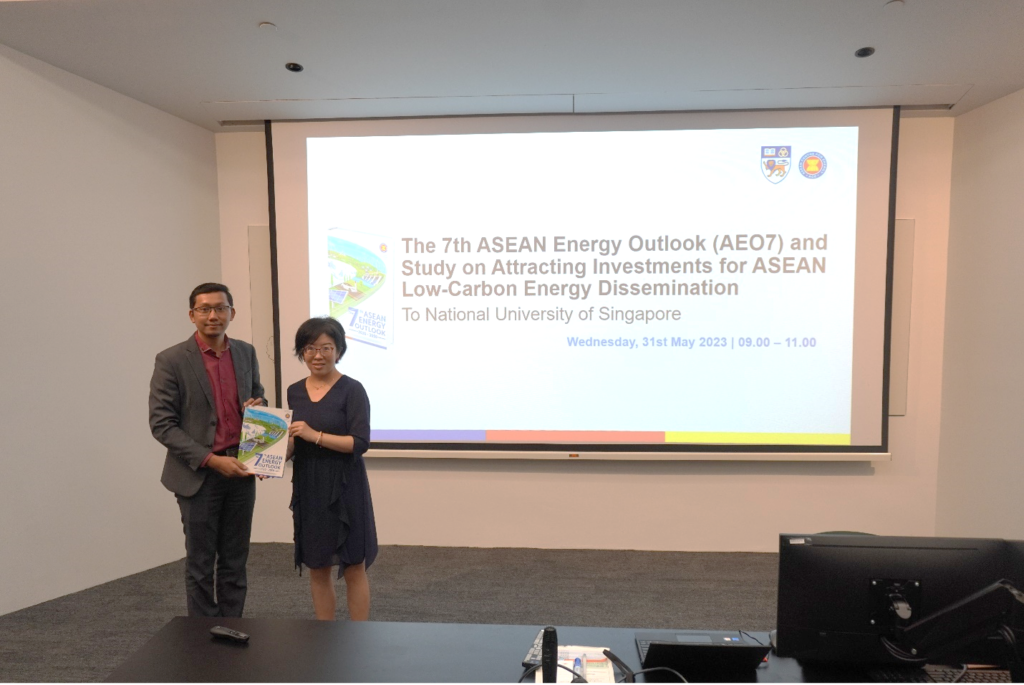Menu

Photo 1. Dr Zulfikar Yurnaidi, Manager of MPP of ACE handed over the printed AEO7 book to Dr Yao Lixia, Senior Fellow at ESI
Enhancing the comprehension of academies in ASEAN regarding the 7th ASEAN Energy Outlook (AEO7) holds importance in fostering a sense of ownership towards the report. This was stated by Dr Zulfikar Yurnaidi, Manager of Energy Modelling and Policy Planning (MPP) at the ASEAN Centre for Energy (ACE), in his welcoming remarks on the AEO7 Dissemination to the National University of Singapore (NUS). Moreover, Dr Yao Lixia, Senior Research Fellow at Energy Studies Institute (ESI), expressed her gratitude for the ACE visitation to share knowledge about the energy landscape in the region.
This event is part of ACE’s continual activity for public engagement of AEO7 dissemination. The dissemination was concurrently conducted to promulgate other ACE studies relevant to the AEO7 findings on “Investments and Measures for Clean Energy and Power Sector Resilience in ASEAN.”
Dr Yao Lixia walked the participants through the discourse on Singapore’s energy policy and ESI support towards the country’s energy agenda. Meanwhile, Dr Zulfikar Yurnaidi introduced the ASEAN Energy Outlook, particularly its role in complementing the regional energy blueprint. He also shared how ACE gathered and processed the data to be developed into an outlook. In his presentation, he highlighted the recent edition of the AEO, which encompasses four scenarios in analysing the historical and projected data from 2005-2050 and modelling approaches used in the study.
Followed by a presentation on AEO7 modelling findings, Ms Amira Bilqis, an Analyst of MPP of ACE, explained that the energy demand and supply are expected to increase sharply by 2050. Amidst the high pressure on energy security, AEO7 projected that ASEAN would become a net importer of natural gas and coal, assuming the continuous utilisation of fossil fuels. Under the ASEAN Plan of Action for Energy Cooperation, the region has set targets to reach 23% renewable energy share in the total primary energy supply, but it only attained 14.2% in 2020. Ms Amira also elaborated on energy-food-land nexus findings, which sparked discussion over the biofuel land requirement.
In the next agenda, Ms Rika Safrina, Senior Analyst of MPP of ACE, disclosed ACE’s recent study on the ASEAN energy transition investments, supported by the Energy Foundation China. According to the AEO7, the total required investment from 2021-2050 is expected to be USD 1,070 billion, but the region has limited public finance, which dominates its current financial source of clean energy investment. The ASEAN Member States have different progress in terms of clean energy targets and finance, thereby, the study proposed a Roadmap with several pathways to determine the most concerning issues in the respective country to build their capacity to attract more investments in the low-carbon sector.

Photo 2. Participants from the AEO7 dissemination at NUS include lead researchers from different clusters
Upon the end of this event, the seminar conducted a question and answer session, which curated an insightful discussion on biofuel and its recommendation for ASEAN to improve the upcoming AEO. Through this dissemination, ACE also hopes for close cooperation with NUS in the future.
